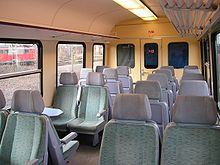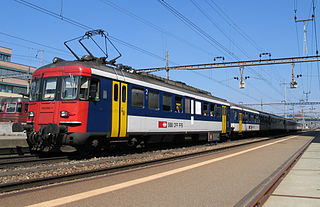
Starting in 1959, the SBB motor coach of the type RBe 4/4 was for a replacement of the old SBB electric locomotives Ae 3/6 I, Ae 3/6 II, Ae 3/6 III and SBB Ae 3/5 with three driving axles. As a consequence, they had much power at their disposal, even more than the Re 4/4 I locomotives, a regenerative brake, cabs on both ends with doors to passenger carriages as well as Multiple-unit train control SBB Vst IIId for multiple-unit or driving trailer. They originally motor coach had 64 seats, 32 smoking and 32 non-smoking, and were painted in ordinary SBB green.
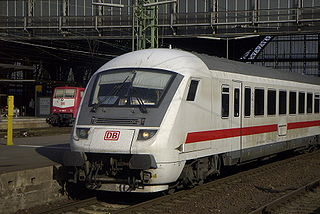
A control car, cab car, control trailer, or driving trailer is a non-powered rail vehicle from which a train can be operated. As dedicated vehicles or regular passenger cars, they have one or two driver compartments with all the controls and gauges required to remotely operate the locomotive, including exterior locomotive equipment such as horns, bells, ploughs, and lights. They also have communications and safety systems such as GSM-R or European Train Control System (ETCS). Control cars enable push-pull operation when located on the end of a train opposite its locomotive by allowing the train to reverse direction at a terminus without moving the locomotive or turning the train around.

Class 624 and class 634 are types of diesel multiple unit, originally operated by Deutsche Bahn.

The Nuremberg Transport Museum in Nuremberg, Germany, consists of Deutsche Bahn's DB Museum and the Museum of Communications. It also has two satellite museums at Koblenz-Lützel and Halle. The Nuremberg Transport Museum is one of the oldest technical history museums in Europe and is a milestone on the European Route of Industrial Heritage (ERIH).

The Uerdingen railbus is the common term for the multiple units which were developed by the German firm of Waggonfabrik Uerdingen for the Deutsche Bundesbahn and private railways after the Second World War. These vehicles were diesel-powered, twin-axle railbuses of light construction. The diesel motors were built into the chassis underneath the vehicle. The VT 95 and VT 98 of the former Deutsche Bundesbahn in particular, are associated with this concept. These vehicles were employed in passenger train duties on branch lines where steam or diesel train operations were less profitable. Including the units built under licence, a total of 1,492 power cars were built from 1950 to 1971; and the total number of units, including trailer and driving cars, was 3,306.

An Ausbesserungswerk is a railway facility in German-speaking countries, the primary function of which is the repair of railway vehicles or their components. It is thus equivalent to a 'repair shop' or 'works'. It is also referred to as a Centralwerkstatt or Zentralwerkstatt or Hauptwerkstatt. During the Deutsche Reichsbahn-Gesellschaft (DRG) period between the two world wars as well as the period of the Deutsche Reichsbahn in East Germany these facilities were called Reichsbahnausbesserungswerke.

These DB Class V 100 diesel locomotives were produced in the late 1950s by the Deutsche Bundesbahn for non-electrified branch lines as a replacement for steam locomotives. The V 100 class was built in three different variants.
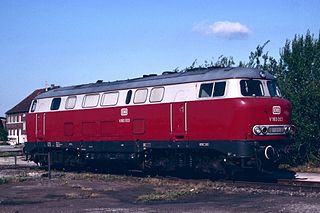
The Class V 160 is a class of diesel-hydraulic locomotives of the German railways. It is the first variant of the V160 family, built for the Deutsche Bundesbahn for medium/heavy trains.

The DB Class 218 are a class of 4-axle, diesel-hydraulic locomotives acquired by the Deutsche Bundesbahn for use on main and secondary lines for both passenger and freight trains.
The Stadler Regio-Shuttle RS1 is the first widely used, new-generation, diesel railcar in Germany and Czech Republic for local railway services. Its most characteristic feature is the trapezium-shaped window frames. The Regio-Shuttle is classified by the Deutsche Bahn as Class 650, by the České Dráhy as Class 840 or Class 841, however numerous private railways have their own Regio-Shuttles.
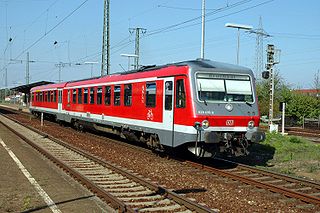
The DB Class 628 is a twin-car, diesel multiple unit operated by the Deutsche Bahn for local passenger rail services.
DB Regio Oberfranken is a business area with the German national railway company, Deutsche Bahn, with its headquarters in Hof (Saale). It is responsible for the majority of regional and local railway services in the Bavarian province of Upper Franconia (Oberfranken).

The Umbau-Wagen or Umbauwagen was a type of German railway passenger coach operated by the Deutsche Bundesbahn (DB) which appeared in the mid-1950s. The name means "rebuild coach" and they were made by rebuilding or converting former state railway (Länderbahn) compartment coaches, many of which were over 30 years old.

A compartment coach is a railway passenger coach divided into separate areas or compartments, with no means of moving between compartments.
The Eilzugwagen was a type of railway passenger coach specially developed for German semi-fast trains, known as Eilzüge. These coaches were first built in the 1930s and continued to be produced until the 1950s. Today all coaches of this type have been retired. A number still run on museum railways.
The Schnaittach Valley Railway is a single-tracked, branch line in the Bavarian province of Middle Franconia in southern Germany. It branches off at Neunkirchen am Sand from the Nuremberg–Cheb railway and runs from there in a northerly direction through the valley of the Schnaittach to its terminal station at Simmelsdorf-Hüttenbach.

The DBAG Class 474/874 is a three-car electric multiple unit train for the Hamburg S-Bahn. The class 474 were built to replace the nearly-60-year-old class 471 trains. Some units have a pantograph (474.3) to service the 2007 opened line to Stade on an overhead catenary track.

Intercity (IC) is the second-highest train classification in Germany, after the Intercity Express (ICE). Intercity services are locomotive-hauled express trains, usually over long-distances. There are Intercity routes throughout Germany and routes generally operate every other hour, with multiple routes giving a more frequent service on core routes. Intercity services are operated by the DB Fernverkehr division of Deutsche Bahn, Germany’s national railway.

The Linke-Hofmann-Busch local traffic prototype coaches were a group of passenger carriages of the Deutsche Bundesbahn.

The MVG Class A is an electric multiple unit (EMU) train type operated by the Münchner Verkehrsgesellschaft on the Munich U-Bahn system. It is the first and oldest type of rolling stock in service on the Munich U-Bahn, and is used on all lines. The prototypes were delivered in 1967, and the full-production units from 1970 until 1983. A derivative of the Class A, the VAG Class DT1, is in service on the Nuremberg U-Bahn system.


